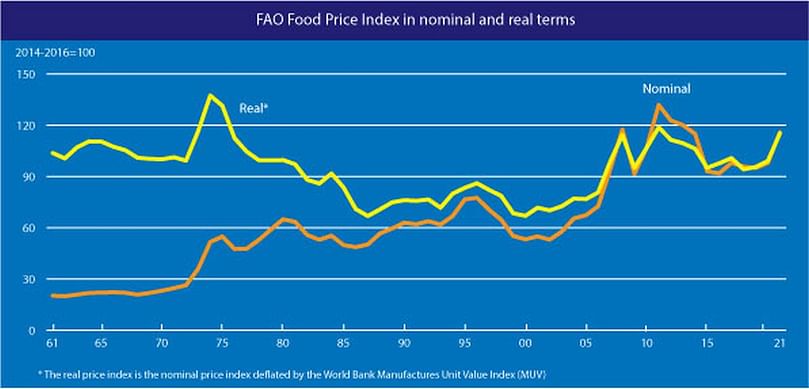FAO Food Price Index rising for tenth straight month
FAO Food Price Index rising for tenth straight month

The FAO Food Price Index (FFPI) averaged 118.5 points in March 2021, 2.4 points (2.1 percent) higher than in February. The increase marked the tenth consecutive monthly rise in the value of the FFPI to its highest level since June 2014. The increase was led by strong gains in vegetable oils, meat, and dairy sub-indices, while those of cereals and sugar subsided.
The FAO Cereal Price Index averaged 123.6 points in March, down 2.2 points (1.7 percent) from February, ending the eight-month rising trend, but still 25.9 points (26.5 percent) above its March 2020 level. Among major cereals, wheat export prices declined the most in March, falling 2.4 percent, however, they remained 19.5 percent higher than in the same month last year.
The month-to-month decline in wheat prices mostly reflected generally good supplies and favorable production prospects for the 2021 crops. International maize and barley prices also fell in March, although continued strong import demand from China prevented them from falling more significantly, and sorghum prices even rose.
Following three months of steady gains, international rice prices edged down in March, as freshly harvested crops began to reach the market and export demand for non-Japonica rice remained slow in all major origins, with the exception of India.
The FAO Vegetable Oil Price Index averaged 159.2 points in March, up 11.8 points (or 8.0 percent) from February and marking its highest level since June 2011. The persistent strength of the index was driven by higher values of palm, soy, rape, and sunflower oils.
International palm oil prices registered a tenth consecutive monthly increase, as lingering concerns over tight inventory levels in major exporting countries coincided with a gradual recovery in global import demand. Meanwhile, soy oil prices rose sharply, largely underpinned by prospects of firm demand, especially from the biodiesel sector.
As for prices of rapeseed and sunflower-seed oils, protracted tightening supplies in, respectively, Canada and the Black Sea region continued to lend support.
The FAO Dairy Price Index averaged 117.4 points in March, up 4.4 points (3.9 percent) from February, rising for the tenth consecutive month and lifting the index to nearly 16 percent above its value in the corresponding month last year.
In March, international butter prices rose, mainly underpinned by somewhat tight supplies in Europe due to a slow start to its milk production season and increased internal demand in anticipation of a foodservice sector recovery.
Milk powder prices also rose, supported by a surge in imports in Asia, especially China, due to concerns over possible short-term sourcing challenges amidst seasonally declining milk production in Oceania and scarce shipping container availability in Europe and North America.
By contrast, cheese prices fell slightly for a third consecutive month due to limited demand for spot supplies.
The FAO Meat Price Index* averaged 98.9 points in March, up 2.2 points (2.3 percent) from February, continuing the upward trend for the sixth consecutive month, but still stood slightly (0.5 percent) below its value a year ago. Poultry and pig meat quotations increased, underpinned by a fast pace of imports by Asian countries, mainly China.
A surge in internal sales in Europe in preparation for the Easter celebrations also supported pig meat prices.
Bovine meat prices remained steady at close to the February levels, as increases in quotations for Brazil and the United States of America compensated for a decrease in export prices from Australia.
By contrast, ovine meat prices fell on increased supplies from New Zealand, as farmers offloaded animals early due to the prevailing dry weather.
The FAO Sugar Price Index averaged 96.2 points in March, down 4 points (4.0 percent) from February, marking the first decline after sharp increases registered in the previous two months. Sugar quotations remained, however, more than 30 percent above their levels in the corresponding period of last year, underpinned by concerns over tight global supplies in 2020/21.
The recent monthly decline in international sugar price quotations was triggered by prospects of large exports from India, despite persisting logistical constraints.
Upward pressure on prices due to strong import demand, particularly from China, and increases in crude oil quotations prevented more substantial price declines in recent weeks.












